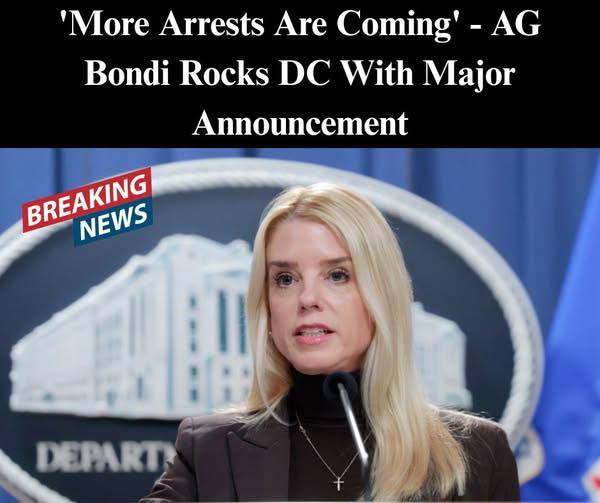In a pivotal move in the ongoing crackdown on one of the most violent gangs operating within the United States, Florida Attorney General Pam Bondi announced the capture of three alleged members of the infamous MS-13 criminal organization. The individuals were charged in relation to the 2015 murder of 22-year-old Gerson Vilelio Vasquez-Portillo in Palm Beach, Florida. Bondi stated that these arrests mark only the beginning, pledging continued efforts to apprehend more MS-13 members as law enforcement intensifies its nationwide campaign.
Those taken into custody were identified as Jose “Chango” Ezequiel Gamez-Maravilla, Wilber “Blue” Rosendo Navarro-Escobar, and Hugo “Power” Adiel Bermudez-Martinez. They are accused of participating in the gruesome killing of Vasquez-Portillo, reportedly a rival gang affiliate, who was stabbed and shot. Although the case had gone cold, it was reopened in 2020, eventually leading to these developments.

A Long Path Toward Accountability
These suspects are not the only individuals tied to a string of MS-13-related killings. The U.S. Department of Justice (DOJ) confirmed that this action is part of a larger initiative targeting gang members connected to multiple homicides in South Florida. The broader investigation has revealed the gang’s use of brutal violence and coercion to dominate rivals and expand influence.
Federal authorities have linked MS-13 to other brutal murders, such as the fatal stabbing of 18-year-old Joel Antonio Canizales-Lara, who was reportedly killed after falsely claiming gang membership, and the shooting of Omar DeJesus Gutierrez, who displayed a rival gang symbol. The latter attack is believed to have been ordered by gang leader Wilson Tirado-Silva.
Tirado-Silva, along with accomplice Melvin David Cruz-Ortiz and others, is now facing serious charges tied to a series of violent crimes. Attorney General Bondi described these arrests as a critical advancement in dismantling the gang’s extensive network.
Federal Crackdown on Gang Leadership
The DOJ also recently reported the arrest of high-ranking MS-13 member Joel Vargas-Escobar, also known by the alias “Momia,” who had been a fugitive for nearly four years. Captured in New York, Vargas-Escobar is accused of orchestrating a conspiracy that led to at least 11 murders. After being deported to El Salvador, he re-entered the U.S. unlawfully and now faces multiple federal charges, including racketeering and murder.
This apprehension is part of a coordinated federal push to bring violent gang leaders to justice. The DOJ’s Criminal Division, in partnership with Joint Task Force Vulcan and the FBI, played a key role in Vargas-Escobar’s capture.
Bondi praised the operation, stating: “The apprehension of another MS-13 ringleader makes our communities safer. Thanks to the collaborative work of the DOJ and Task Force Vulcan, and with President Trump’s support, we will continue our relentless pursuit until this violent network is dismantled.”
MS-13’s Broad Criminal Enterprise
The Department of Justice classifies MS-13 as a transnational criminal gang primarily composed of individuals from El Salvador and other Central American countries. With an estimated 10,000 members operating across at least 10 U.S. states and the District of Columbia, as well as a presence in Mexico and Central America, the gang is infamous for its violent operations, including extortion, homicide, and narcotics trafficking.
MS-13 is structured around small groups called “cliques,” each led by individuals known as “shot callers.” These leaders direct a range of illegal activity—from arms smuggling and drug distribution to the recruitment of new members and carrying out targeted killings.
Known for its extreme violence, the gang often uses bladed weapons and firearms to carry out attacks, typically targeting rival gang members or perceived traitors. MS-13 also engages in extortion and human trafficking, constantly seeking to expand its influence across geographic regions.
Communities Living in Fear
The gang’s reign of terror has left lasting trauma in many communities, especially in areas where MS-13 maintains a strong presence. Fear and silence often dominate neighborhoods under gang influence, making it difficult for residents to collaborate with authorities. The killings of Canizales-Lara, Gutierrez, and Vasquez-Portillo are just a few examples that illustrate the senseless and destructive violence attributed to the group.
Federal operations targeting MS-13 are viewed as crucial steps toward reclaiming safety in these communities.
Strategic Response to Gang Crime
The Trump administration’s focus on eradicating MS-13 is part of a broader policy aimed at reducing organized criminal activity and improving public safety. Significant federal resources have been allocated to agencies such as the DOJ, FBI, and U.S. Customs and Border Protection to track, arrest, and prosecute gang members—especially those in leadership roles.
Efforts to dismantle MS-13 extend beyond U.S. borders. Cross-border collaborations with law enforcement in Mexico and Central America have resulted in key arrests and disrupted some of the gang’s international operations.
Continuing the Pursuit of Justice
Although major arrests have been made, authorities stress that the campaign against MS-13 is ongoing. Law enforcement continues to seek fugitives and disrupt the gang’s financial networks, aiming to choke off its income and operational capacity.
This strategy includes targeting the gang’s illegal enterprises and ensuring that its members face full legal consequences for their crimes.
The Role of Interagency and International Collaboration
The progress made in curbing MS-13’s reach would not be possible without strong partnerships between federal, state, and local agencies. Groups such as ICE, DEA, and CBP have played essential roles in supporting investigations. Additionally, cooperation with international law enforcement in Central America and Mexico remains critical to addressing MS-13’s global footprint.
As efforts continue, these collaborative approaches are vital in securing lasting results against the gang’s transnational influence.
Conclusion: Persistent Resolve Against Gang Threats
The recent arrests and heightened efforts to dismantle MS-13 highlight the federal government’s commitment to protecting American communities. While notable progress has been achieved, the fight is far from over. MS-13’s criminal activities—including murder, drug smuggling, and human trafficking—continue to threaten public safety.
However, with steadfast law enforcement coordination and community vigilance, more arrests are expected, and MS-13’s reach can be further diminished. The mission remains clear: bring offenders to justice, support victims’ families, and restore peace to affected neighborhoods.


